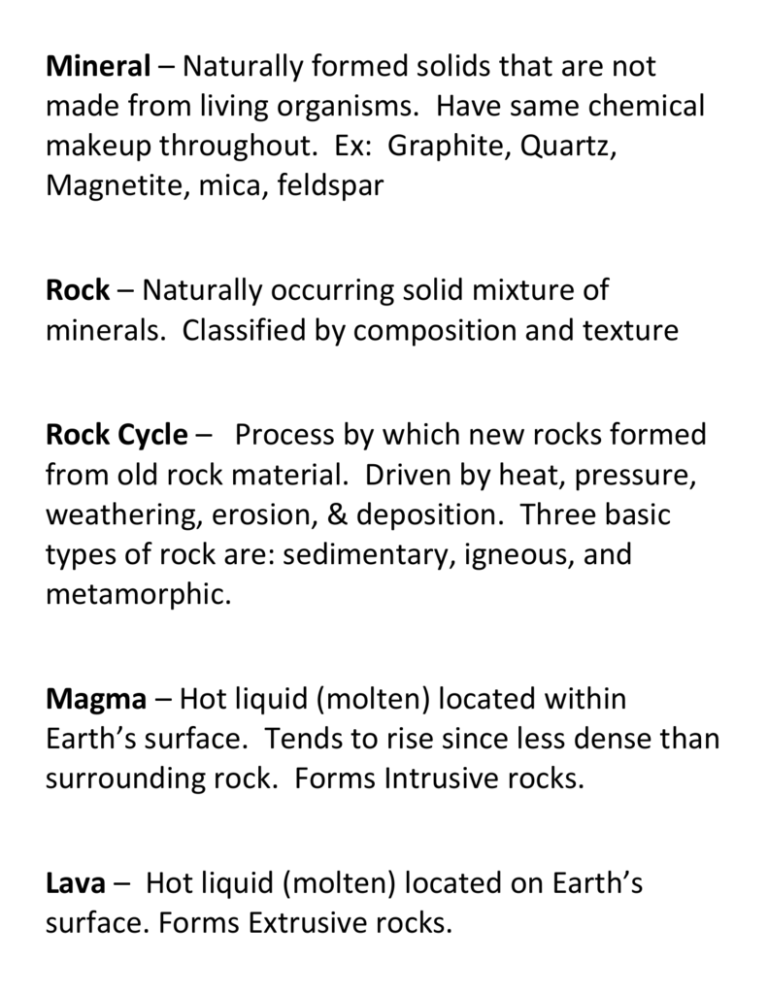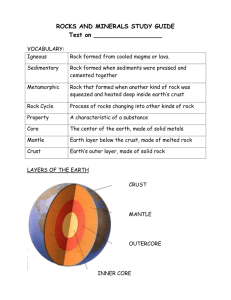Mineral – Naturally formed solids that are not made from living
advertisement

Mineral – Naturally formed solids that are not made from living organisms. Have same chemical makeup throughout. Ex: Graphite, Quartz, Magnetite, mica, feldspar Rock – Naturally occurring solid mixture of minerals. Classified by composition and texture Rock Cycle – Process by which new rocks formed from old rock material. Driven by heat, pressure, weathering, erosion, & deposition. Three basic types of rock are: sedimentary, igneous, and metamorphic. Magma – Hot liquid (molten) located within Earth’s surface. Tends to rise since less dense than surrounding rock. Forms Intrusive rocks. Lava – Hot liquid (molten) located on Earth’s surface. Forms Extrusive rocks. Igneous Rock – Word meaning “from fire.” Rock that formed from magma or lava. “Ignite means to light fire” 2 Types of Igneous Rock 1. Intrusive – Rock formed from inside the Earth from magma. Magma cools slowly = coarse large-grained minerals/crystals. Ex: Gabbro, diorite, granite 2. Extrusive – Molten rock (lava) that cools rapidly above the Earth’s surface. finegrained minerals or no visible minerals. Ex: Basalt—forms oceanic crust Obsidian—black glass w/ no visible crystals, Pumice—porous rock less dense than water (many holes due to escaping gases) Scoria—dark and more dense than water Sedimentary Rock – Forms when rock or mineral fragments are physically or chemically weathered, eroded, deposited, compressed & cemented together 3 Types of Sedimentary Rock 1. Clastic – Form when fragments of other rocks are squeezed together Ex: Conglomerate, sandstone, shale, breccia, coquina 2. Chemical – Form when dissolved minerals crystallize Ex: Halite, limestone(CaCO3) 3. Organic – Form from remains of plants and animals Ex: Plants PeatLigniteBituminous CoalAnthracite CoalGraphiteDiamond 5 Steps to form a Clastic Sedimentary Rock: 1. Weathering – Water, wind, ice, & heat breaks down rock into fragments, called sediments. Physical Weathering – breaking down rocks by wind or water. Shape & appearance change BUT NOT composition. Chemical Weathering – Process in which chemicals break down the composition of a rock into new materials. Ex: Acid rain & rusting. 2. Erosion – Process by which sediment is removed from its source (mountains) by wind, H2O, ice or heat. 3. Deposition – Process in which sediment moved by erosion is dropped & comes to a rest, (River beds) 4. Compaction: Sediments are pressed together under their own weight. 5. Cementation: Dissolved minerals crystallize and glue particles of sediment together in one mass. Metamorphic Rock – Rocks in which texture or composition have changed by heat and pressure, but are not melted. Can begin as igneous, sedimentary, or metamorphic rock. 2 Types of Metamorphic Rock 1. Foliated –Mineral grains are arranged in colored layers or bands due to separation of minerals with different densities. Ex: Slate--from shale Gneiss--from conglomerate or granite Schist-2. Non-foliated – Mineral grains are NOT arranged in layers or bands Ex: Marble-from limestone Quartzite--from sandstone 3 Methods of Heat Transfer within the Earth: 1. Conduction – Heat transfer by direct contact of particles. A spoon in a pot of hot soup also becomes hot from direct contact w/the soup. 2. Convection – Heat transfer by movement of heated liquids or gases due to differences in temperature and density. Soup on the stove will heat at the bottom, rising due to higher temp and lower density than the cold soup at the top of the pot. 3. Radiation – Heat transfer through the air/empty space without one object touching another. The sun warming the Earth’s surface is radiation. Layers of the Earth from the surface to the core 1. Lithosphere – Rigid part of the Earth. It is made up of 2 parts: the crust and the rigid part of the mantle. The crust—oceanic and continental, is divided into pieces called tectonic plates. a. Crust – Outermost layer of the Earth Oceanic Crust – Thin-5km max, below the ocean floor Continental Crust – Thick 100km, at tallest mountains. b. Mantle – Layer between the crust and the core. No one has drilled through the crust to reach the mantle. 2. Asthenosphere – Middle of the mantle. Solid rock, but very slow “soft” moving layer directly below the lithosphere, on which the tectonic plates move. 3. Mesosphere – lowest part of the mantle. 4. Outer Core – Liquid layer mostly of Iron 5. Inner Core – Solid layer mostly of Iron OTHER NOTES: HEAT ENERGY: Also called thermal energy. Total energy of atoms in a material, is measured as temperature oF, oC Types of Heat Energy: CONDUCTION: Transfer of energy by direct contact. Ex: metal pan touching burner on stove CONVECTION: Transfer of energy by circulation of a liquid or a gas in a circular pattern. Ex. Water in a pan on the stove moving from the bottom of the pan to the top of the pan. RADIATION: Transfer of energy as electromagnetic waves. Ex. Coils of toaster toast bread by radiating visible light and infrared waves.







